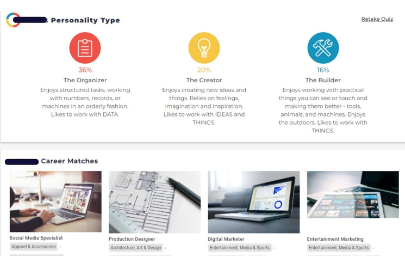- 03 Mar 2024
- 8 Minutes à lire
-
Contributeurs

-
Impression
-
SombreLumière
-
PDF
Gladeo Behind-the-Scenes: The Research That Backs Our Strategy
- Mis à jour le 03 Mar 2024
- 8 Minutes à lire
-
Contributeurs

-
Impression
-
SombreLumière
-
PDF
Many of our potential customers and partners ask us: “What makes Gladeo so different from other platforms?”
The short answer? Our program incorporates tested career development research and evidence-based theories.
Now here’s the longer answer!
The Gladeo career navigation platform has been solidly rooted in research since its inception. Our approach to impactful content creation and product design utilizes findings from career development theory studies, sociology and psychology research, and learning science principles—along with mountains of empirical evidence we’ve personally collected and analyzed during our years in the industry.
Now let’s take a closer look at the key frameworks underlying our practical, synthesized approach!
The Four Key Frameworks
The four research-based frameworks that serve as key guides to our design and content creation strategy are:
Social Cognitive Career Theory (SCCT),
Motivational Theory of Role Modeling (MTRM),
Growth Mindset and Social Emotional Learning (GM), and
Culturally Responsive Teaching.
Social Cognitive Career Theory (SCCT)
In 1986, psychologist Albert Bandura put forth his Social Cognitive Theory (SCT), suggesting that learning occurs in a social context through observation, imitation, and modeling, influenced by personal factors, environmental influences, and behavior.
In the mid-1990s, Bandura’s ideas were used as a foundation for Social Cognitive Career Theory (SCCT), proposed by Robert Lent, Steven Brown, and Gail Hackett. SCCT expanded SCT into the realm of career development. It provided a framework for understanding how people form career interests, make educational and career choices, and achieve career performance.
It also proposed that three intricately linked variables serve as the basic building blocks of career choice and success:
Self-efficacy beliefs,
Outcome expectations, and
Personal goals in driving career-related behaviors.
Self-efficacy beliefs are assumed to derive from four primary sources of information:
Personal performance accomplishments,
Vicarious experiences (e.g., observing similar others),
Social persuasion, and
Physiological and emotional states.
Meanwhile, outcome expectations refer to beliefs about the consequences or outcomes of performing particular behaviors (e.g., what will happen if I do this?).
Put simply: in addition to their personal goals, people consider their self-efficacy and think about outcomes before they engage in activities—and their conclusions affect how much effort and persistence they exert.
The more people believe they’ll succeed, the harder they’ll try (and the more likely they will be) to succeed.
Here’s how we put SCCT to work on the Gladeo platform:
First, learners take our Gladeo Quiz to determine their Holland’s personality type and survey their interests, to receive recommended career pathways (see our insert below about the Holland occupational themes).
Using these recommendations, learners can review our in-depth career profiles. Each profile covers a popular, good-paying career field and features step-by-step guidance on the tasks workers do. Every profile also raises outcome expectations by providing a detailed career progression map outlining promotion and advancement opportunities.
Our embedded career videos raise self-efficacy beliefs through vicarious learning and social persuasion. The videos feature informational interviews starring a diverse range of accomplished professionals from all walks of life. This allows learners to draw inspiration and motivation as they hear the stories of people they can relate to, people who have found success on their career journeys.
We raise outcome expectations through our career profile links, Program Finder, and Newsfeed of helpful resources, opportunities, and events. With these tools, learners can easily discover relevant educational and training programs, scholarship opportunities, community support organizations, job and internship opportunities, and networking events. This increases their awareness of and access to existing, relevant career development resources and showcases local support organizations and events, giving them everything they need to succeed.
The Gladeo quiz further raises self-efficacy beliefs by affirming multiple intelligences (as outlined in Harvard psychologist Howard Gardner’s Theory of Multiple Intelligences). These intelligences are:
Body-kinesthetic
Interpersonal
Intrapersonal
Linguistic-verbal
Logical-mathematical
Musical
Naturalistic
Visual-spatial
“In order to capture the full range of abilities and talents that people possess, Gardner theorizes that people do not have just an intellectual capacity, but have many kinds of intelligence…,” writes Verywell Mind.
The connection between Gardner’s Theory of Multiple Intelligences and Social Cognitive Career Theory lies in how an individual’s unique combination of intelligences influences their career choices and development through the lens of self-efficacy and outcome expectations in SCCT.
The Holland Occupational Themes
The Holland Occupational Themes were developed by psychologist John Holland, who believed that one’s “choice of a career is an expression of personality.”
The six Holland personality types are:
.png)
Realistic – “Do-er” or “Builder”
Investigative – “Thinker” or “Problem Solver”
Artistic - “Creator”
Social - “Helper” or “People Person”
Enterprising – “Persuader”
Conventional – “Organizer”
Everyone possesses traits from more than one personality type, so the Gladeo Quiz shows the quiz taker’s top three personality types, ranking each with a percentage score (i.e., 36% Organizer, 20% Creator, 16% Builder).

We label and interpret the Holland types as follows:
Builder (Realistic) - Enjoys working with practical things you can see or touch, like tools, animals, and machines. Enjoys the outdoors and is good with their hands, tools, and anything to do with physical skills.
Problem Solver (Investigative) - Loves to solve conflicts. Is analytical and inquisitive.
Creator (Artistic) - Enjoys creating new ideas and things. Relies on feelings, imagination, and inspiration. Thinks outside the box to generate new ideas.
People Person (Social) - Enjoys serving and helping others.
Persuader (Enterprising) - Self-starter. Great at public speaking; performs well as a leader. Can sell ideas and products. Comfortable dealing with all types of people.
Organizer (Conventional) - Enjoys structured tasks, working with numbers, records, or machines in an orderly fashion. Likes to work with data. Likes rules and order.
The Motivational Theory of Role Modeling (MTRM)
The Motivational Theory of Role Modeling (MTRM) was first presented in a 2015 study published by the Review of General Psychology. Using expectancy-value theories of motivation, the authors proposed that role models influence aspirants’ goals by:
Acting as behavioral models
Representing the possible, and
Being inspirational
To effectively raise self-expectations, role models must be perceived as similar to the subject—and can’t be perceived as exceptions to the rule. Only role models with the appropriate traits are effective at delivering information which can improve self-efficacy beliefs such as “vicarious experiences” and “social persuasion” (as outlined in SCCT).
Using Gladeo, learners can watch videos of similar others (e.g., persons with similar backgrounds such as low-income, first-generation college graduates, community college graduates, or underrepresented minorities) sharing their stories, life experiences, and challenges they’ve overcome to reach a fulfilling career. These videos showcase inspirational behavioral models that represent “the possible.”
Growth Mindset
Stanford psychologist Carol Dweck’s Growth Mindset research was prompted by seeing a photo of her 5-month-old nephew staring in amazement at a computer. “It struck me: That’s what we were all like. We were all once that excited about learning something new,” she stated during a 2019 lecture.
Her findings indicated two different mindsets that people may possess—a “fixed mindset” and a “growth mindset.”
A fixed mindset causes us to assume that our character, intelligence, and creative ability are basically unchangeable. As a result, we’re less inclined to believe in our ability to affect change in our lives or to improve our status in a meaningful way.
A growth mindset, in contrast, thrives on challenge and sees failure as a springboard for growth.
According to Dweck’s theory, people manifest their predominant mindset at an early age, affecting a great deal of our future behavior, our rates of success and failure, and even our ultimate capacity for happiness.
After learners take the Gladeo quiz, they discover their personality types and can use the interest survey results to view recommended career pathways. This helps them to learn more about their strengths, subtly shifting their mindset from a “how intelligent are you?” framework (typical of most academic tests) to a more empowering “how are you intelligent?” mindset.
When learners watch our spotlight videos and see people express their growth mindset and experiences of growing from failure, it helps them believe they, too, can learn new things and improve. We also help to cultivate greater self-awareness, so learners can recognize their personal strengths and objectively understand the areas they can work on. This allows them to build the grounded sense of confidence and optimism needed to achieve a growth mindset.
Gladeo’s career program roadmaps show learners what their futures could look like if they focus on career growth. These roadmaps are like flowcharts, revealing multiple possible career entry and/or advancement pathways, listing educational/training options and/or common job titles from entry- to mid- and senior-level roles.
Culturally Responsive Teaching
Culturally Responsive Teaching uses relevant, relatable cultural references to empower learners intellectually, socially, and emotionally. The goal is to capture their attention by connecting classroom activities with student interests, using familiar styles, culture, vocabulary, and even music or sports.
As EducationWeek explains, the essential aspects of culturally responsive teaching are:
A strong knowledge base about cultural diversity
Culturally relevant curricula
High expectations for all students
An appreciation for different communication styles
At Gladeo, we take all of the above aspects seriously and try to incorporate elements of each into all of our content.
For our interview video, courses, and written content, we use visual styles and vocabulary that are accessible and relatable, compared to the dry, uninspiring content found on most platforms. Our format tends to be short-form, fast-paced, authentic, and high-energy—with a consistent focus on diversity and inclusion.
The messaging in our content is not only informative and engaging but consistently positive and encouraging, showing learners that we believe in their potential and want them to set high expectations for themselves. By using our step-by-step platform, we can show them how to identify their short-term goals, turn them into a reality—and then set even higher long-term goals!
Conclusion
Most career platforms merely recycle basic, outdated content pulled from static government resources such as the Bureau of Labor Statistics or O*NET. But learners and teachers alike have told us they struggle to use such tools because the information just isn’t relevant, compelling, or comprehensive enough.
Gladeo only uses government sources as a starting point to conduct our own research, referring back to our four guiding frameworks as we go. We reference authoritative industry-specific sites offering “insider info” along with university program pages, job portals, and a diverse array of other trusted sources. We also conduct one-on-one interviews with real-life professionals to gather and share crucial insider advice, procedural knowledge, and testimonials, adding a human face and personality to each career path.
At every step, the above-listed frameworks serve to direct our team as we continue to grow and iterate a career development intervention to effectively help all students overcome the unique challenging barriers they face when choosing, starting, and pursuing their career journeys.


